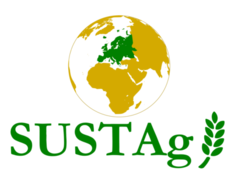SUSTAg
Assessing options for the SUSTainable intensification of Agriculture for integrated production of food and non-food products at different scales (SUSTAg)
Project abstract
The broad EU public expects agriculture to provide food security, protect the environment and biodiversity, and sustain rural communities and landscapes. Beyond these expectations, agriculture must be highly adaptable in the face of climate change and volatile market and political conditions, in which the demand for food and non-food crops is set to increase. The creation and support of a competitive European bioeconomy offers the opportunity to simultaneously address food security and nonfood crop demand, while at the same time providing the opportunity to reduce the negative impacts of agriculture on the environment.
Within this context, the overarching aim of SUSTAg is to identify both generic and location-specific integrated production systems and other sustainable intensification measures (SI) at the global/European and case study level which are optimal across different sustainability dimensions (ecological, economic and social). The feasibility of actually operationalizing the different systems will be evaluated with three regional case studies and on the European level. The study will make use of innovative crossdisciplinary (e.g. crop science, farm systems, supply chain, economic) and multi-scale (global, European, regional) integrated modelling analysis, with global and European scale analysis setting economic and political boundary conditions regarding the relative competitiveness of case study regions. At each scale, evaluation of SI options will consider: production conditions; dynamics in demand for food and non-food products; resource use and availability; socio-economic and policy environment; and climate change. Results will be presented in transparent and relevant SI evaluation metrics to allow stakeholders to analyze and weigh tradeoffs at each of the case study and European scales.
Stakeholder engagement and interaction at all stages of system design and analysis is sought as the best options and pathways to integrated food and non-food production depend on specific context and stakeholder values. The ultimate outcome of SUSTAg will be a set of stakeholder relevant options for sustainably increasing food and nonfood production within an emerging European bioeconomy.
Methods and materials
SUSTAg builds on a multi-scale modelling approach integrating the global, European and regional level. To ensure consistency, the global and European scale analysis will provide the boundary conditions to the case studies. All levels work with a consistent and harmonized set of agricultural-specific climate, socio-economic, and policy scenarios.
We focus on three integrated production systems, each represented by one case study:
- Dual use of energy and food crops (Spain).
- Production of food crops using the crop residues for applications in the bio-based economy (Netherlands and Germany).
- Biogas production from manure and non-food crops (Finland).
Results will be discussed with the relevant stakeholders in order to explore the feasibility of implementing the production systems and summarized and generalized in a framework of SI metrics.

Target groups
Model-aided identification of promising SI options and integrated production systems and their representation in a multidimensional metric:
1. helps policy makers at different levels to design policies according to societal goals, and
2. can support farmers in their investment decisions in the context of a bio-based economy
Expected results
The outcome of SUSTAg will be a set of options for sustainably increasing value creation within an emerging European bio-economy that are tested across scales. This is accomplished by evaluating integrated production systems and SI options in specifically designed metrics considering
- Economic profitability and the potential contribution to the bio-based economy, and
- Environmental impacts and vulnerability to climate change. The framework of metrics will enable informed discussion and tradeoff evaluation that support farm management and institutional/policy design.
Research gaps
The relatively small size of the research project and the available modelling tools do not allow for direct upscaling of all findings from the case study level to a European or even global scale and hence for consistent consideration of dynamic feedbacks across scales. However, consistency across scales is ensured by the use of harmonized scenarios and top-down framing constraints.
Publications
Mouratiadou et al. (2020). Sustainable intensification of crop residue exploitation for bioenergy: opportunities and challenges. Global Change Biology Bioenergy, 12, 71–89.
Stella et al. (2019). Estimating the contribution of crop residues to soil organic carbon conservation. Environmental Research Letters, 14, 094008.
Copernicus Institute of Sustainable Development. 10.12.19. Exploitation of crop residues for bioenergy: is it possible without harming the environment?

International Scientific Workshop on Sustainable Intensification Metrics
Within the frame of the FACCE SURPLUS project SUSTAg, an international scientific workshop on sustainable intensification metrics was held in Berlin on Monday May 22 2017. The workshop was held as a pre-conference meeting to the MACSUR Science Conference 2017.
Coordinator:
Christoph Müller
Potsdam Institute for Climate Impact Research (PIK)
Germany
Email: Christoph.Mueller@pik-potsdam.de
Project partners:
- Natural Resources Institute Finland (Luke), Finland
- University of Bonn (UB), Germany
- Copernicus Institute, Utrecht University (UU), The Netherlands
- Universidad Politécnica de Madrid (UPM), Spain
- Andalusian Institute of Agriculture Research and Training (IFAPA), Spain
- Agrathaer, Germany